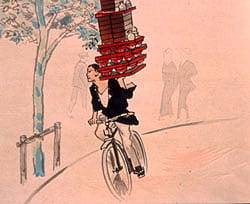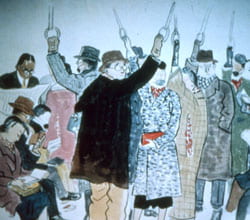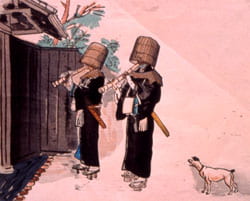The Occupations of Shôwa Japan in Pictures: The Woodblock Prints of Wada Sanzô
July 17, 2004 – October 17, 2004
Modern Japanese society and culture is often imagined in dramatic conflict between western-style modernity and enduring tradition. This tension emerged in the Meiji era (1868-1912) and continues today, but was most pronounced during the early Shôwa period (1926-1989). This was a time when the nation rejected European values as part of war ideology, then enthusiastically re-embraced western culture during the Allied Occupation of 1945-52.
The complexity of Shôwa society is glimpsed in two series of color woodblock prints designed by painter Wada Sanzô (1883-1967): The Occupations of Shôwa Japan in Pictures first published in a 48-print series between 1938 and 1941; and the 24-print Continued Occupations of Shôwa issued from 1954 to 1956. These images capture the pulse of Japanese life during the tumultuous decades of the 1930s, 1940s and 1950s. In the words of their publisher Shinagawa Kiyoomi, this is truly the
“ukiyo-e of Shôwa.”
Wada was uniquely qualified to capture the contradictions of modern Japan. Trained in academic oil painting, Wada was an establishment artist, painting for the Imperial family, government and military, teaching at the prestigious Tokyo School of Fine Arts, and serving as co-president of the Artist’s Patriotic League from 1943-45. Wada also explored Asian artistic traditions, studying textiles in India and Kyoto, and ending his career by painting in the native nihonga style and designing tapestry theater curtains. Wada’s pioneering color research resulted in his winning an American Motion Picture Academy Award in 1955 for color costume design for the film Gates of Hell.
Wada was noted for his figure drawing and luminous color—qualities wonderfully displayed in his prints. Prints from his watercolor originals display the refined technique of Japanese woodblock printing. Wada’s prints also raise vital issues about the qualities of Japanese society and culture that allowed the nation to quickly adjust from anti-western militarism to pro-American reconstruction. Wada’s Occupations series suggest that a focus on everyday life — whether with new “western”
trends, remnants of traditional culture or a synthesis of the two — provide a critical link between war-era nationalism and the commodification of traditional Japanese life basic to post-war “Americanization.”
USC Pacific Asia Museum presentation is the first time the two Occupation series will be shown in their entirety. Exhibited alongside some of the images are the brief essays that Wada wrote for them. In addition, the show will include some of Wada’s various post-war prints showing traditional customs of Kyoto, and his three-postcard series Sketches of G.I. in New Japan.
All of the prints, lent by a local collector, were originally assembled by Richard Miles, a long-time friend of USC Pacific Asia Museum. The exhibition is curated by Kendall H. Brown, specialist in modern Japanese prints and a professor of art history at California State University, Long Beach.
Related Programs:
The Evolution of Japanese Woodblock Prints
Friday, July 23, 11am-12pm
Dr. Kendall H. Brown, curator of Occupations of Shôwa Japan: Prints by Wada Sanzô, will survey the printing techniques, styles and subjects of Japanese woodblock prints from 1700-1956.
Authors on Asia
Art of the Japanese Postcard: Masterpieces from the Leonard A. Lauder Collection
Friday, July 30, 7pm
From the late 19th to the early 20th century, Japan was a vital world center for postcard art. More than just casual pieces, these postcards were often designed by prominent artists of the day and had a strong visual impact that belied their modest format. Dr. Kendall H. Brown has published widely in the fields of Japanese art and Japanese popular prints of the early 20th century and is curator of the museum’s current exhibition, The Occupations of Shôwa Japan in Pictures.
Curator’s Tour
Saturday, August 7, 2004
Dr. Kendall Brown will give a special tour of the exhibition, Occupations of Shôwa Japan: Prints by Wada Sanzô.
The American Occupation of Shôwa Japan
Saturday, September 11, 2004, 1-2pm
Thoughts on the 20th Century Social Re-engineering of Japan
While the exhibition Occupations of Shôwa Japan: The Woodblock Prints of Wada Sanzo documents the visible results of Western influence on the daily lives of Japanese citizens, philosophical and cultural changes also occurred. Dr. Ronald A. Morse, The Tokyo Foundation Professor of Japan Studies at the University of Nevada, Las Vegas, will detail the challenges and conflicts resulting from this meeting of different cultures.


